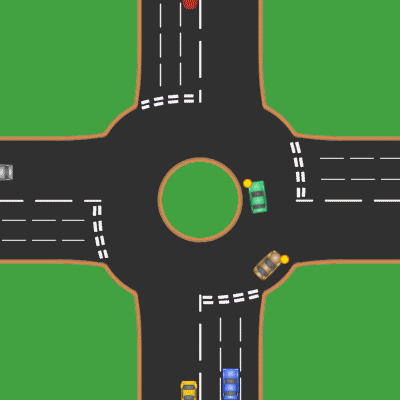Our town just got its first roundabout. There is a second one opening within the next two weeks (supposedly). I have heard countless people stress out, complain, predict doom and disaster, and criticize the city over this.
It's only a roundabout, folks. It's just an intersection with a circle in the middle. They exist in every country, and so far, have not brought down the apocalypse. They are in fact safer and better at regulating traffic. Easier on your gas too, cutting down on all that stop-and-starting stop signs make you do (which in essence is better for the environment, pollution-wise).
But I understand that for those who have never used a roundabout (sometimes called a traffic circle or rotary), it can be a little intimidating. And if you are unsure of the rules of a roundabout, I can see how you might approach one with a little confusion and trepidation.
So I'm giving you five little roundabout rules and tips that will hopefully make you feel a little more confident next time you approach one.
1. Fifirst thing to realize is that roundabouts are basically the same thing as a four-way stop, only with a yield (and an island in the middle). Imagine that island as a large piece of roadkill you don't want to run over. You'd bend around it right? And that's what you do at a roundabout.
The rules of a four-way stop apply. The person who approaches from the right of you has right of way. You don't - I repeat DON'T - have to come to a full stop each time you approach. But you do have to yield if anyone else besides you is approaching or already on the roundabout.
2. Saying that, unlike a four-way stop where everyone proceeds one at a time, you can actually enter the roundabout simultaneously with someone else if they are coming the opposite direction or are far enough around the roundabout for you to SAFELY enter it too. This is why it's so effective for traffic control. If you can safely slide in without slowing anyone on the roundabout down, you may proceed.
3. This is why SIGNALLING is so important on a roundabout. Here's a breakdown of when and where to signal.
Upon approaching roundabout,
If you are going to take the first exit (on the right), signal RIGHT.
If you are going straight through the roundabout, do NOT signal at all UNTIL you have passed all the exits on the right, then signal right to indicate you are now taking the straight across exit.
If you are taking any exits in between the first right and straight on, don't signal until you have passed the last exit before your exit, then signal right to take your exit.
If you are going left (any exit past straight on), signal LEFT upon approaching the roundabout. This allows everyone else approaching from other exits to know that you are going to be passing by all of them. Keep signalling left until you approach your exit, then signal right to take your exit.
4. Roundabouts let you legally do U-turns. You can just approach the roundabout, signal left and keep signalling left until you've made your full U (then signal right to exit). You can even do a full circle if you want, but this is rarely necessary unless you missed your exit, are completely lost or have trouble making decisions and can't cope with too many choices.
5. Go slowly. Always be aware of who is entering, exiting, approaching, and already on the roundabout. Slot in where safe to do so. Stop only when you have to, otherwise, yielding is fine. Always be aware when you are approaching that someone may be about to cross in front of you, even if they are not signalling. Not everyone knows to signal and not everyone bothers to signal. Don't blindly trust other people's signalling either. Just like you wouldn't pull out in front of a car onto a street simply because they are signalling to turn (because you never know if they are actually turning until they start to), do the same with roundabouts. Roundabouts have rules, but not everyone follows them.
Hopefully, however, this little set of rules will help YOU follow and understand the rules, and maybe teach someone behind you a little about signalling, and hopefully your new roundabout will be a safe and effective traffic installment, not a disaster waiting to happen.
For more information, click on this helpful little graphic of a simple four-way roundabout from Wikipedia.
I am resisting the urge to mark this with the label 'death'.

Where I first learned roundabouts everyone was driving on the wrong side of the road ;o) After the initial shock I've come to love that way of handling traffic (roundabouts, not driving on the flinkin' left).
ReplyDeleteSeriously though, Alison taught me the correct way to navigate, however, no one but me was doing "correct", so I went with the flow and stayed to the outside rather than moving to the inside until approaching my exit. Also, roundabouts on smaller roads are often only one lane anyway.
This one is only one lane, so it's pretty foolproof. Multi-lane ones are easy too if you just know the rules and follow them, but like you said, so many people don't! I learned which roundabouts had their "own" rules and just followed the flow of traffic in those. You could get yourself killed following the rules in some of those places where no one does it right!
DeleteLori,
ReplyDeleteThis is awesome! First, I'm sharing it. But honestly, maybe we should have it on the Community center website!
We should! I'd feel like a dork being the one to share it though!
Delete